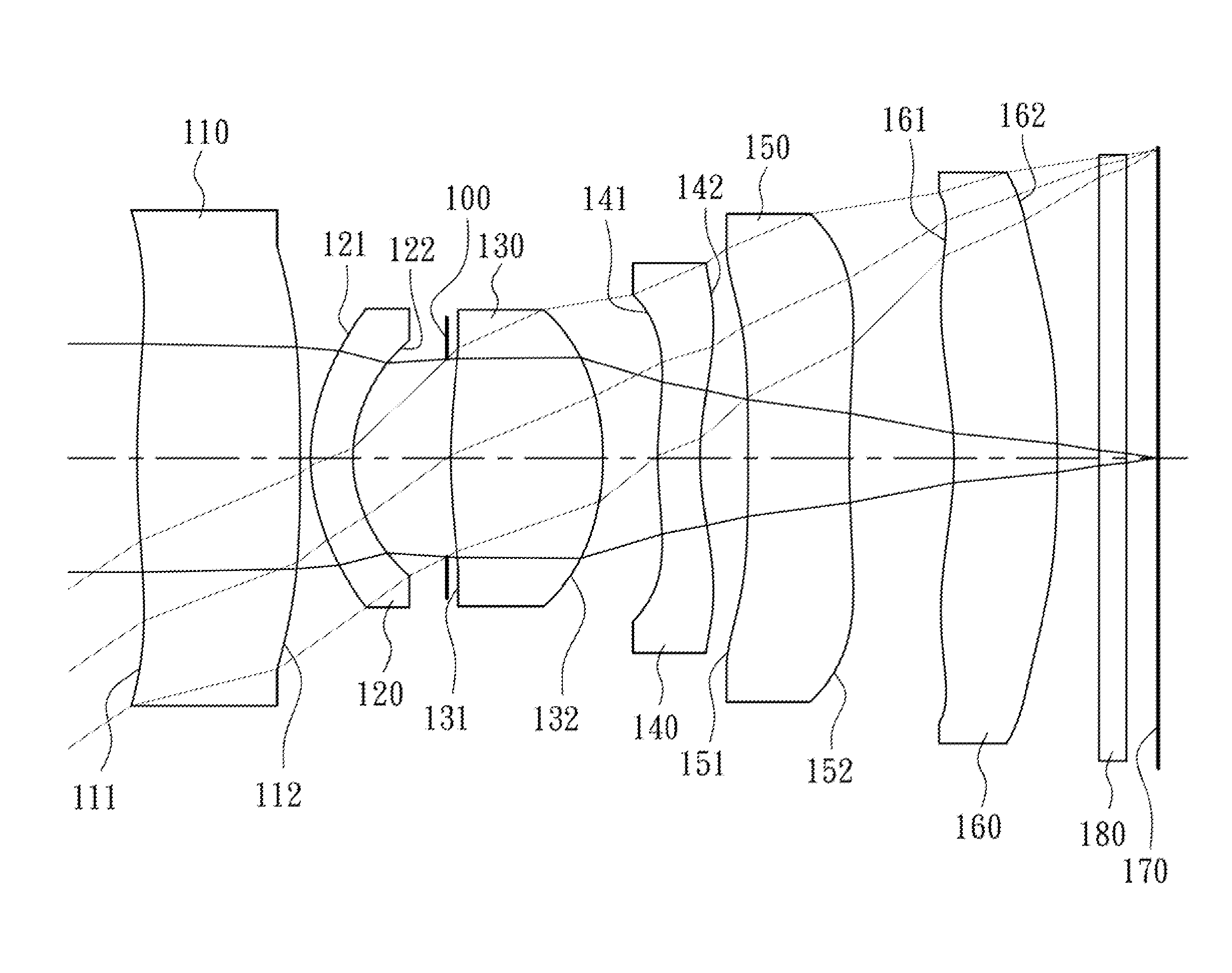Image capturing lens assembly
a technology of image capturing and lens assembly, which is applied in the direction of instruments, television systems, and scanning details of television systems, can solve the problems that the conventional four-piece lens structure cannot meet the requirements of the compact image capturing lens assembly
- Summary
- Abstract
- Description
- Claims
- Application Information
AI Technical Summary
Benefits of technology
Problems solved by technology
Method used
Image
Examples
first embodiment
[0075]The equation of the aspheric surface profiles of the aforementioned lens elements of the first embodiment is expressed as follows:
X(Y)=(Y2 / R) / (1+sqrt(1-(1+k)×(Y / R)2))+∑i(Ai)×(Yi)
[0076]wherein:
[0077]X: the height of a point on the aspheric surface spaced at a distance Y from the optical axis relative to the tangential plane at the aspheric surface vertex;
[0078]Y: the distance from the point on the curve of the aspheric surface to the optical axis;
[0079]k: the conic coefficient; and
[0080]Ai: the i-th aspheric coefficient.
[0081]In the image capturing lens assembly according to the first embodiment, f is a focal length of the image capturing lens assembly, Fno is an f-number of the image capturing lens assembly, HFOV is half of the maximal field of view, and they satisfy the following relationships:
f=5.31 mm;
Fno=3.20; and
HFOV=34.0 degrees.
[0082]In the image capturing lens assembly according to the first embodiment, the Abbe number of the second lens element 120 is V2, the Abbe num...
second embodiment
[0101]The detailed optical data of the second embodiment are shown in Table 3, and the aspheric surface data are shown in Table 4 as follows.
TABLE 32nd Embodimentf = 5.22 mm, Fno = 3.20, HFOV = 37.3 deg.FocalSurface #Curvature RadiusThicknessMaterialIndexAbbe #length0ObjectPlanoInfinity1Lens 14.847100 (ASP)1.213Plastic1.53554.511.64220.000000 (ASP) 0.0703Lens 21.638160 (ASP)0.310Plastic1.61425.5−7.2241.110300 (ASP)0.7915Ape. StopPlano0.0306Lens 33.818000 (ASP)1.235Plastic1.53554.52.547−1.872650 (ASP) 0.2338Lens 43.601300 (ASP)0.335Plastic1.61425.5−6.3391.803750 (ASP)0.37810Lens 514.115300 (ASP) 0.711Plastic1.53554.5−120.641111.377800 (ASP) 0.81912Lens 6−5.109700 (ASP) 0.874Plastic1.53554.5−6.781313.193100 (ASP) 0.30014IR-filterPlano0.200Glass1.51764.2—15Plano0.22516ImagePlano—Note:Reference wavelength (d-line) is 587.6 nm.
TABLE 4Aspheric CoefficientsSurface #123467k =0.00000E+000.00000E+001.72069E−01−3.76271E−02−1.18997E−01−3.39293E−01A4 =−2.41424E−02−4.67307E−02−6.62441E−02−9.12979...
third embodiment
[0112]The detailed optical data of the third embodiment are shown in Table 5, and the aspheric surface data are shown in Table 6 as follows
TABLE 53rd Embodimentf = 5.22 mm, Fno = 3.00, HFOV = 33.5 deg.FocalSurface #Curvature RadiusThicknessMaterialIndexAbbe #length0ObjectPlanoInfinity1Lens 15.668008 (ASP)1.056Plastic1.53556.39.532−47.172124 (ASP) 0.0703Lens 21.506234 (ASP)0.310Plastic1.65021.4−7.7341.064690 (ASP)0.7345Ape. StopPlano0.0306Lens 34.542792 (ASP)1.039Plastic1.53556.32.797−2.045953 (ASP) 0.2888Lens 43.196435 (ASP)0.310Plastic1.61425.6−8.3591.896690 (ASP)0.34210Lens 515.498349 (ASP) 0.770Plastic1.53556.3−58.111110.160607 (ASP) 0.82712Lens 6−2.811467 (ASP) 0.630Plastic1.53556.3−5.5013−68.890140 (ASP) 0.30014IR-filterPlano0.200Glass1.51764.2—15Plano0.22416ImagePlano—Note:Reference wavelength (d-line) is 587.6 nm.
TABLE 6Aspheric CoefficientsSurface #123467k =0.00000E+000.00000E+000.00000E+000.00000E+000.00000E+000.00000E+00A4 =−2.64969E−02−4.30098E−02−8.55147E−02−1.34186E−01−...
PUM
 Login to View More
Login to View More Abstract
Description
Claims
Application Information
 Login to View More
Login to View More - R&D
- Intellectual Property
- Life Sciences
- Materials
- Tech Scout
- Unparalleled Data Quality
- Higher Quality Content
- 60% Fewer Hallucinations
Browse by: Latest US Patents, China's latest patents, Technical Efficacy Thesaurus, Application Domain, Technology Topic, Popular Technical Reports.
© 2025 PatSnap. All rights reserved.Legal|Privacy policy|Modern Slavery Act Transparency Statement|Sitemap|About US| Contact US: help@patsnap.com



